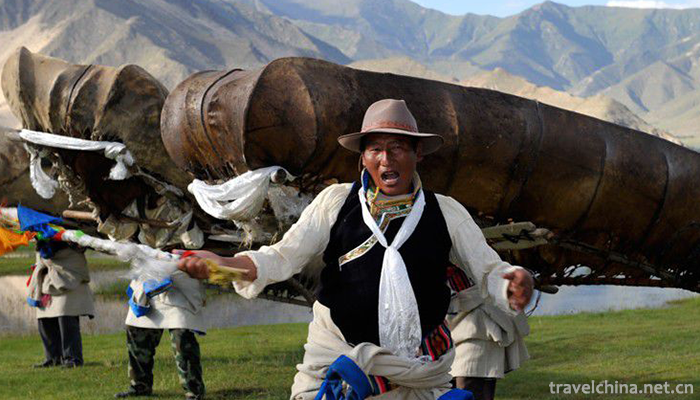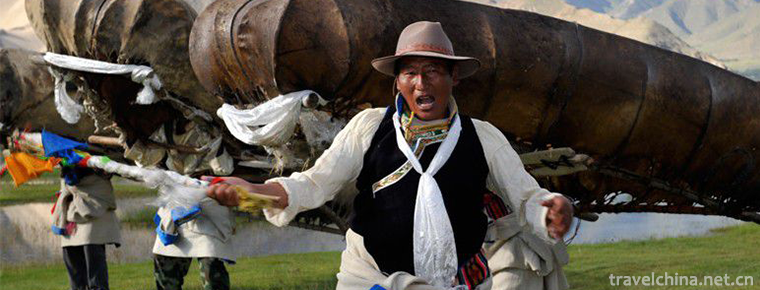Kuozi Guzi
Kuozi Guzi
Guzi, also known as "Guzi Dance" and "Cowskin Boat Dance", is a unique folk dance of two groups of Junba in Chabalang Village, Qushui County, Tibet Autonomous Region. In 2008, Junba Fishing Village was listed as the national intangible cultural heritage. Dance by singing while dancing "Ah Ge" and the boatman who backed the cowhide boat and hit the boat sounded for rhythm dance performance. The whole dance is vigorous, rough and simple.
Forms of expression
The whole dance of Guzi is vigorous, rough and simple. Guzi performed in cooperation with boatmen who sang and danced alongside the "Ah Ge" and the cowhide boat on their backs and hit the boat to make sounds for rhythmic dancing. "A Ge" is the leader of Guozi dance. When dancing a cow-skin boat, "Ah Ge" sings and dances with the "Tower" (colorful flagpole). Several other dancers (usually 4-6 people) watch the "Ah Ge" movement, carrying about thirty or forty kilograms of cow-skin boat on their backs, and follow the "Ah Ge" dance with the same movement. Everyone's movements are neat, and the sound of pulp hitting the ship's side is endless, light and dignified. Guozi dance is a kind of self-entertainment and self-enjoyment of Junba people after monotonous and heavy work. Often after fishing, several people gather together, carrying a cow-skin boat, singing and dancing, the hardship of life in singing and dancing becomes relaxed and happy.
historical origin
Guzi originated from "Zhongzi" (Yak Dance). Many movements of dancing Guzi have the characteristics of "plateau boat" - yak.
Junba village is the only village in Lhasa which mainly produces fisheries. "Junba" means "catcher" or "fisherman" in Tibetan. Geographically, Junba village is located in the lowest reaches of the Lhasa River, surrounded by mountains on three sides and facing water on one side. Historically, Junba village has been blocked by traffic and scarce arable land. Fishing was once their only way of survival. Junba villagers who make a living by fishing have created a unique fishing culture in the long-term labor process.
The small calfskin boat is not only a fishing tool for Junba villagers, but also a prop for dancing after they work.
In the past, Junba fishermen had to take long-distance water freight service to the old local government every year, mainly to transport tea, salt, cattle and wool, groceries and so on. From Mozhugongka County in eastern Lhasa to Lhasa or Shannan, cattle tankers can be seen on a total of 230 kilometers of waterway. The Kraft can only drift upstream to downstream, not upstream. When they reached their destination, the boatmen dried the tanker, carried it on their shoulders and carried it back to their place of departure.
Over the years, drifting on the river, singing kayak songs and dancing kayak dances have gradually become a unique form of entertainment for boatmen.
primary coverage
Dance
In fact, the complete Guzi is divided into four sections. The first paragraph is called "narrative". A dancer named "A Ge" said the opening line: "Shenniu patronizes Junba village, eats grass on the East mountain, drinks spring at the foot of the West mountain, rolls and plays on the pasture, and practices gladiatorial fighting in the bullpen."
The second paragraph is called "Zhongzi" (yak dance). The boatmen were first in "miscellaneous! Za ang! Za ang! " At the same time, "Ah Ge" sings "Blessing Song" while dancing.
The third paragraph is called "Chaohada". "Ah Ge" sings "Blessing Song" and takes Hada out of his Tibetan robe and puts it on the sand while jumping. The kayak dancers bend forward while jumping, and lift Hada from the ground with the left and right upper corners of the kayak on their backs.
The fourth paragraph is to sing "Blessing Song". The main idea of the lyrics is: "Today we meet here, I hope we can meet regularly. I wish you all good health, people you often meet. After singing, Ah Ge took the lead in saluting the audience.
Boat song
There are two kinds of boat songs: one is long and soothing, such as the river is passing away, such as the clouds are long, with a strong Lyric color, this kind of song is sung by the boat as it drifts across the vast river; the other is the trumpet, which is from the boatmen's heart when they fight with the wind and waves, short and warm. Some are just wordless songs, ups and downs, in tune with the waves, or even integrated.
Skill inheritance
According to a 2010 survey, only the elderly Zasang in Junba fishing village is the only "Ah Ge" in the village. He hopes to teach some young people to perform "Ah Ge", but the young people in the village, including his three children, are not interested in the cowhide boat dance. With the death of the old people in the village, the production skills and inheritance of the kayak dance are facing a crisis.


-
1.Wenchang chicken
Hainan Wenchang chicken, special product of Wenchang City, Hainan, China national geographical indication product.
Time 2018-11-05 -
2.Yunnan Wildlife Park
Yunnan Wildlife Park is located in Qingshuihe Village, Fengyuan Road, Panlong District, Kunming City (beside Yunnan Forestry Department), 10 kilometers from the urban center of Kunming City
Time 2018-12-22 -
3.the Capital Cities and Tombs of the Ancient Gaogouli Kingdom
Gaogouli is located in Ji'an City, Jilin Province. It includes domestic cities, Wandu Mountain City, 14 Royal mausoleums and 26 noble tombs. Domestic city and Wandu Mountain City
Time 2019-01-12 -
4.Tangjiahe Scenic Area
Tangjiahe Scenic Area is located in Qingchuan County, Guangyuan City, Sichuan Province. Subtropical monsoon climate. National AAAA-level tourist attractions. Established in 1978, it covers a total are
Time 2019-02-13 -
5.Hui Costume
The main symbol of Hui costume is the head. Men like to wear white caps. Hui women often wear a hood. Older Hui women wear black or brown headscarves in winter
Time 2019-05-04 -
6.Siming Nanci
Siming Southern Ci is also called "Siming Documents". A kind of traditional local folk art in Zhejiang Province. Tanci, spoken and sung in Ningbo dialect. It is popular in Ningbo, Zhejiang P
Time 2019-06-16 -
7.Really Different zhenbutong Making Skills of Luoyang Watermat
It's really different from Luoyang's water mat making skills. The traditional handicraft in Luoyang City, Henan Province, is one of the national intangible cultural heritages.
Time 2019-07-25 -
8.Brown Fan Dance
On the day of the grand Brown fan dance festival, adult men gather in groups on a square with their own delicacies and rice wine every day, and hold a large-scale Brown fan dance activities by arrangi
Time 2019-08-16 -
9.Cao Zhi
Cao Zhi (192 - 232 December 27th), Zi Jian, Pei Guo Qiao County (now) Anhui province Bozhou City, born in East Wuyang (now Shenxian, Shandong, Juancheng). Cao Cao He was born with third sons from Quee
Time 2019-09-07 -
10.Giant Sleeping Buddha
The giant Sleeping Buddha is located in Leshan City, Sichuan Province. In the periphery of Leshan Giant Buddha, there is a "giant Sleeping Buddha" with a total length of more than 4000 meters and composed of several mountains.
Time 2020-10-15 -
11.Longtouguan
Longtouguan, a cultural relic protection unit in Sichuan Province. Located in Jiangyang West Road, Jiangyang District, Luzhou City, Sichuan Province. Originally an ancient pass, it was built in the Shu Han Dynasty to build a wall for the earth; it was rebuilt in the 11th year of Chongzhen in the Ming Dynasty and rebuilt in the second year of Tongzhi in the Qing Dynasty.
Time 2020-10-16 -
12.Animal resources in Neijiang
The animal resources in Neijiang are mainly livestock, poultry and some wild animals. Domestic animals include mammals, birds, insects, fish and domestic wild animals. There are pigs, cattle, sheep, rabbits and a small number of horses, mules and donkeys
Time 2020-12-16